David R
Forbes
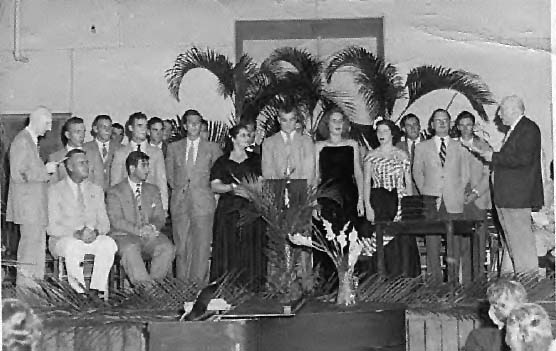
Thomas A.
Edison College Class of 1948
David R
Forbes

Thomas A.
Edison College Class of 1948
Ann Cook (formerly Daniels) was born in Fresno, California on Apriol 25, 1924. She met Barney Daniels, Jr. at a Navy Hospital in San Leandro, California where she was stationed as a medical Assistant and a Physical Therapy assistant in the Navy working with the wounded GIs returning from the Pacific Theatre of World War II. In 1946, she married Barney and came to Ft.Myers with him. She was twenty-two. She and Barney attended Thomas A. Edison College located on First Street downtown. Soon after opening, the school moved to the decommissioned Buckingham Air Base located in East Lee County. After the school vacated the First Street building, the location became the Ft. Myers American Legion Hall.
Ann
& Barney Jr. at their campus dormitory in
1946 At
first Ann and Barney were living with his parents on Jackson
Street. However, soon after the move of the college the old
barrack were converted into dormitories and they moved on
campus.
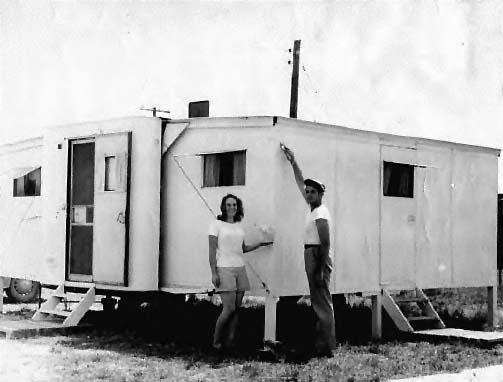
Ann spoke very highly of her in-laws, but she knew this was a good
time for she and Barney to move out on their own and the "new campus"
provided just that opportunity. Ann graduated in 1948 and her
concentration in business studies led her into the banking business
in Lee County. She became a loan officer for First Federal Savings
and Loan and was one of the first women to hold this position in the
banking community.
|
Barney became a city policeman after his graduation. He later became a Florida State Trooper, responsible for patrolling the Moore Haven Area of the Southwest Florida District of the Highway Patrol. |
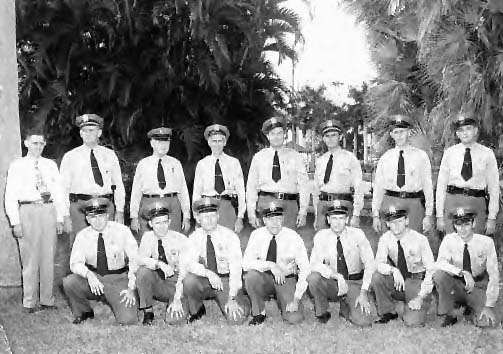 . .
Ft. Myers City Police, 1948 |
(Below) Florida Highway Patrol 1950
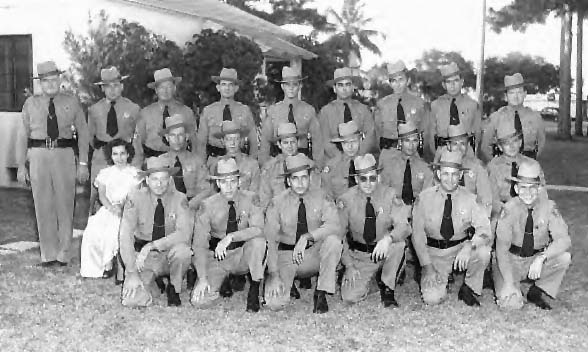
Social life in Ft Myers focused in the area of downtown Ft. Myers. Private parties and dances were the main events. The Exhibition Hall was not there in the 40s; the "Civic Center" was at that location. It was here that the dances and balls took place. This location on Edwards Drive later became "The Hall of 50 States". In those days, Lee County's claim to fame was the huge gladiolus fields in the Iona Area. This was so predominant that the area was known as Lee County, Florida, "The Gladiolus Capital of the World". Ann described the Gladiolus Ball as being the height of social occasions, with only one exception, The Edison Pageant of Light Parade. Ann was the "Edison College Pageant Queen" in 1948 and represented the school in the parade. Barney led the Mounted Horsemen at the rear of the parade. Ann remembered, "After the horsemen rode through, the Dunbar Community was allowed to march in the parade. The fact that this occurred seemed a little odd to me, but I realized this was just the way things were here". Ann recalled the first time she remembered anyone from the Dunbar Community displaying animosity toward this situation -- it was the black veterans back from World War II who were not very happy with the way things still were, and rightfully so. Ann recalled other friends like the sheriff "Snag"
1948 Edison
Pageant of Light Parade Thompson, who
lived across the street from Barney Sr. on Jackson Street.
She said "He was a friend to everyone, and helped out as
many people as possible. He was very familiar with nearly
all the Lee County people, and we always felt safe and
secure.

(Barney Jr. riding "Sonny")
With twenty deputies, he did it well, and with style, and with friendship toward everyone, and he did the best. Of course, there were some people, who did some things who deserved to be in what we called "Snag's Hotel". By and large, he was considered fair with everyone." ("Snag Thompson" was the sheriff of Lee County from 1948-1972.) When asked if she knew any other local notables, she replied "Back then, everybody knew everybody." I replied by asking if she thought this was the "Good Old' Boy" network in the making? She said "Yes and it was wonderful."
|
Barney Daniels, Senior, "The Cattleman", was born just south of Punta Gorda in the late 1890s. Ann recalled that by the time she arrived here in 1946, he was a fairly large cattle rancher here in Lee County. Although she was not here in the 1920s, she was able to tell me from family knowledge about the early life of Barney Sr. He lived on a houseboat near the boat basin area of downtown Ft. Myers. He came to Ft. Myers in 1915. He and his wife worked several |
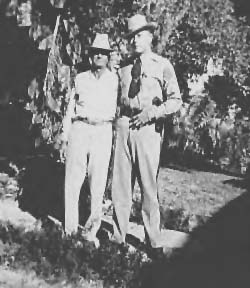
Barney Daniels Sr. and Jr., 1950 |
jobs and owned small
businesses, including fruit stands that specialized in citrus
packages that were shipped to the northern United States. He also
owned a pool hall in Ft. Myers. All of these efforts were put forth
to save money to begin cattle herding. He started with a small herd
of 10-12 cattle. By 1927, he ranched two sections of land. He also
leased two more sections that connected to his own land. This land,
located in South Ft. Myers, bordered a two-lane cattle trail. That
two lane trail, now known as Daniels Parkway, is six lanes and the
gateway for all that arrive in Lee County by air in our bustling
world of 1999. Daniels' cattle operations, located at the corner of
Daniels Road and Plantation Road, had the loading pens and branding
stations. The cattle were shipped to Arcadia, Florida via truck by
1946. Prior to that, before World War II, the cattle were driven to
the Iona Docks on open cattle drives. Spring roundup was the busiest
time of all and Ann recalled one spring, she and Mrs. Daniels helped
out by handholding runs of fencing to keep the cattle from straying
while being herded from one area along the ten-mile canal to
another.
The local cattlemen enjoyed an amiable relationship through the years. The local Cattlemen's Association gathered on a regular basis. They shared ranching information, particularly that related to disease amongst herds. Cattle rustling, in those days, also kept the alliance of cattle ranchers strong in this area. Barney Daniels, Sr. ranched until the early 1970s when he retired. He and his wife lived out their years in their home on Jackson St. in Ft.Myers. They both survived into their 90s and with their passing, along with others of their generation, Lee County said good-bye to the early pioneers of this century.
|
Going to the beach was fun in the 40s. By that, Ann means the actual trip to the beach. Gladiolous Drive was the most popular way to travel to Estero Island. "Old Toad Town Road" is what they called that road then. It connected to San Carlos Boulevard and that took you through the old coquina arches, over the wooden swing bridge, and to the beach. The mangroves on the side of the road were very thick. |
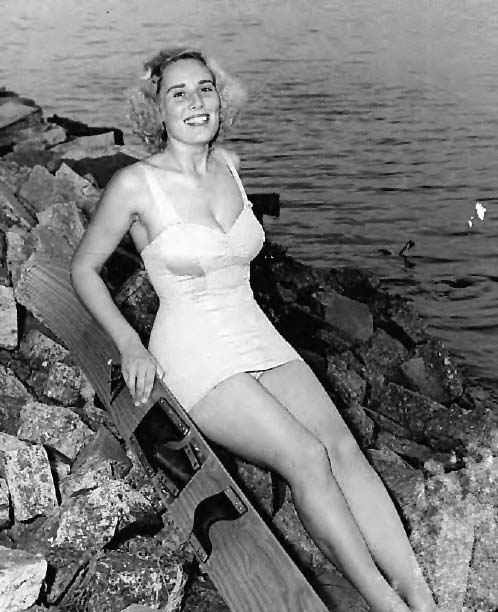 |
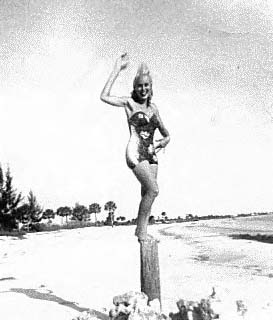
Looking south from Ft.Myers public beach, 1950 |
Many times fiddler crabs would swarm by the thousands across the road. Ann said "I felt so bad for all those little crabs that sometimes I would have the car stopped and would try to shoo them off the road." Once arriving to the beach, Ann said "We would drive right up on the beach, beautiful clean white sand in both directions, blue green water so clear you could be in water up to your neck
|
|
Our discussion turned to the topic of land development in the area. Ann now resides on Plantation Road, less than a half of a mile from the site where Barney Sr.'s cattle pens and loading docks were located. She is surrounded by development. Not a patch of woods is left in nearly two sections of land that just twenty years ago were still wild. Golf courses and gated communities have gobbled up all but a thin corridor of wildlife sanctuary. And, they now play baseball in the swamp! Ann's personal reaction to this demise is simply this, "I think we have suffered, for the most part, with all the development. Everything that most people come here to see, to enjoy, to do, is being totally destroyed." |
|
Much appreciation to Ann Cook for graciously agreeing to this interview and providing personal photos and newspaper clippings to support its findings. This interview took place on November 21, 1999 at the home of Ann Cook.
|
|
|